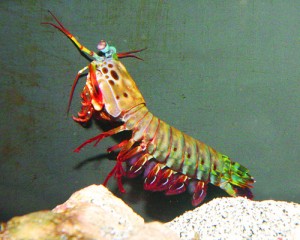Flanders family finds elusive crustacean

Janice Fleming was walking along the beach at Indian Island County Park on a sunny day last month when her 3-year-old son, Tristan, pointed to a pair of googly eyes staring up at them from the water.
Upon closer inspection, the Flemings, who hail from Flanders, realized those eyes belonged to a small and extremely unusual looking crustacean that had mandibles, pinchers and about a six-inch tail.
“I picked him right up,” Ms. Fleming said. “I put him in a little bucket and he tried to flip. I didn’t realize he was trying to pinch me.”
They assumed their new pet was a baby lobster, and Ms. Fleming’s 9-year-old daughter, Lakota, held the bucket on the drive home.
But the Fleming family, which also includes daughter Breana, 15, and dad Kevin, soon realized the creature didn’t much look like a lobster, a shrimp or any other sea creature they’d ever seen. After a Google search for “life cycle of crustaceans,” Ms. Fleming realized what they’d found: a mantis shrimp.
Neither a shrimp nor a mantis, the mantis shrimp is native to our area, though it is rarely seen because it lives in deep burrows and is nocturnal, according to Atlantis Marine World biologist Todd Gardner. The species got its name because it looks like a cross between a shrimp and a praying mantis.

“It’s not something you would see normally being at the beach swimming or fishing,” Mr. Gardner explained.
At home, the Flemings put the mantis shrimp in a plastic tank, having read that mantis shrimp can crack glass tanks with their powerful tails.
Mr. Fleming said the family would travel to the bay twice a day to circulate their little habitat with new saltwater. They also fed it mussels, snails and tiny shrimp that they pulled from the bay.
Even with all that special attention, the little guy died last Sunday after about a 10-day stay with the Flemings. Tristan seemed puzzled as to why the creature, which he had come to call “Shrimpy,” was not moving as he examined the exoskeleton.
“He was just so cool,” Mr. Fleming lamented.
Mr. Gardner said the mantis shrimp was probably sick because they don’t usually hang out near surface waters. He said Atlantis gets a call about twice a year from someone who’s found a mantis shrimp, frequently near the Shinnecock Canal in Hampton Bays. Atlantis has its own mantis shrimp on display.
“If you go diving, sometimes you come across a whole expanse of hundreds of holes,” he said. “They’re about two inches deep. If you shine a flashlight you can see them.”
The creature can be brown, like the one the Flemings found, or brightly colored like the one at Atlantis.
As for the Flemings, they plan to stay on the lookout for another pair of bug-like eyes.
“He was just so beautiful in the water,” Ms. Fleming said. “I don’t know if I’ll ever catch another one.”








